NCERT Exemplar for Class 11 Physics - Kinetic Theory - Free PDF Download
NCERT Exemplar Class 11 Physics Chapter 13 Kinetic Theory provides answers to the NCERT Exemplar book's Exemplar questions. Extra questions produced by Vedantu experts will aid you in your preparation for CBSE Class 11 and entrance exams such as NEET, JEE, JEE advance, and AIEEE. There are MCQs in this NCERT exemplar Class 11 Physics Chapter 13 PDF. Matching, fill-in-the-blank, and true/false questions, as well as numerical problems, key derivations, worksheets, exercises, and HOTS, are included in the book.
Access NCERT Exemplar Solutions for Class 11 Physics Chapter 13 - Kinetic Energy
1. A cubic vessel (with faces horizontal + vertical) contains an ideal gas at NTP. The vessel is being carried by a rocket which is moving at a speed of
(a) remains the same because
(b) remains the same because motion of the vessel as a whole does not affect the relative motion of the gas molecules and the walls.
(c) will increase by a factor equal to
(d) will be different on the top wall and bottom wall of the vessel.
Ans. option (b)
The relative speed of molecules with relation to the walls of a container doesn’t convert in a rocket because the mass of a molecule is negligible with relation to the mass of the whole system and the system of gas moves as an entire and
2.
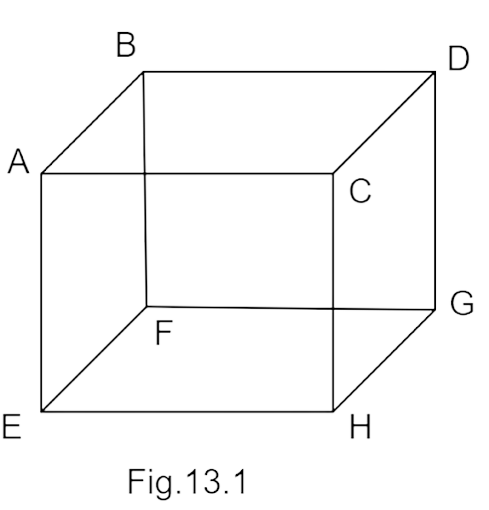
(a) the pressure on
(b) the pressure on all the faces will be equal.
(c) the pressure of
(d) the pressure on
Ans. option (d)
The wall experienced pressure due to the force exerted by molecules on walls because of its rate of transfer of momentum to the wall. Due to elastic collision and magnitude of momentum transferred to the wall by each molecule is
3. Boyle’s law is applicable for an
(a) adiabatic process
(b) isothermal process
(c) isobaric process
(d) isochoric process
Ans. option (b)
We know that Boyle’s law is relevant at constant temperature and the temperature remains constant in isothermal processes.
Thus, option (b) is correct.
4. A cylinder containing an ideal gas is in vertical position and has a piston of mass
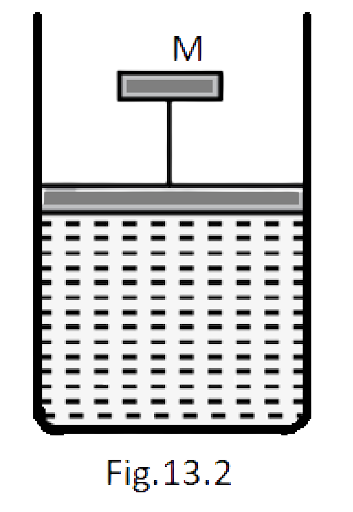
(a) both
(b) only
(c)
(d)
Ans. Option (c)
On the ideal gas, the pressure exerted does not convert from initial to final position. According to the given arrangement
Where
Thus, on increasing the temperature of the system, it’s volume will increase but
5. Volume versus temperature graphs for a given mass of an ideal gas are shown in Fig. 13.3 at two different values of constant pressure. What can be inferred about the relation between
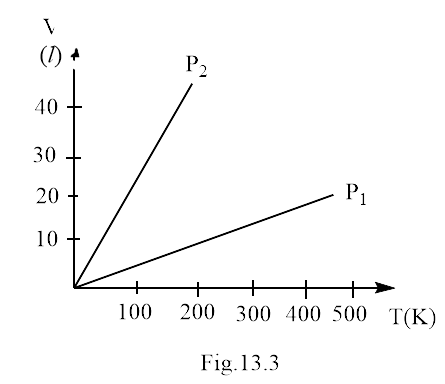
(a)
(b)
(c)
(d) data is insufficient
Ans. option (a)
As we know that the pressure and the quantity of gas in the system are constants. Thus, by using ideal gas equation
Or slope of graph is constant
or
thus,
This shows that slope
6.
(a) same as the pressure initially.
(b)
(c)
(d)
Ans. option (c)
Because of the rate of change of momentum
Let the speed of the
Thus, pressure does not change due to change into atomic form at same temperature
But
Thus, pressure must be
7. A vessel of volume
(a)
(b)
(c) Neither
(d)
Ans. Option (b)
The number of molecules
For
Number of molecules for
8. An inflated rubber balloon contains one mole of an ideal gas, has a pressure
(a)
(b)
(c) less than
(d) between
Ans. option (d)
According to ideal gas equation
Where
So,
Or
i.e.,
MULTIPLE CHOICE QUESTIONS-II
9. ABCDEFGH is a hollow cube made of an insulator (Fig. 13.4). Face ABCD has a positive charge on it. Inside the cube, we have ionized hydrogen. The usual kinetic theory expression for pressure

(a) will be valid.
(b) will not be valid since the ions would experience forces other than due to collisions with the walls.
(c) will not be valid since collisions with walls would not be elastic.
(d) will not be valid because isotropy is lost.
Ans. options (b) and (d)
There will be electrostatic force due to the pressure of hydrogen ions and positive charged wall ABCD which acts a part of collision, thus Kinetic theory of gas is not applicable. The isotropy also vanishes because of the appearance of ions in place of hydrogen molecules. So, options (b) and (d) are correct.
10. Diatomic molecules like hydrogen have energies due to both translational as well as rotational motion. From the equation in kinetic theory
(a) the total energy per unit volume.
(b) only the translational part of energy because rotational energy is very small compared to the translational energy.
(c) only the translational part of the energy because during collisions with the wall pressure relates to change in linear momentum.
(d) the translational part of the energy because rotational energies of molecules can be of either sign and its average over all the molecules is zero.
Ans. option (c)
The postulate of kinetic theory of gases state that it is assumed that pressure created by gas molecules is because of the perpendicular forces only exerted by molecules on the wall during the motion of molecules, i.e., the molecule striking at any other angle except
11. In a diatomic molecule, the rotational energy at a given temperature
(a) obeys Maxwell’s distribution.
(b) have the same value for all molecules.
(c) equals the translational kinetic energy for each molecule.
(d) is
Ans. option (a) and option (d)
Let us suppose a diatomic molecule along
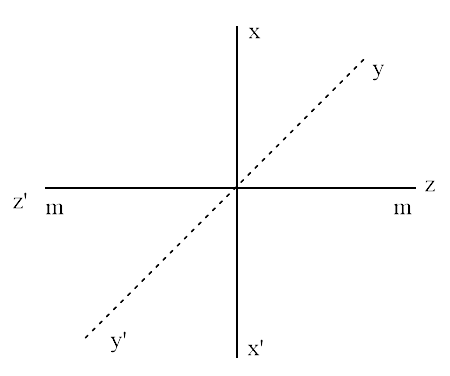
The individualistic terms given in the above expression is
12. Which of the following diagrams (Fig. 13.5) depicts ideal gas behaviour?
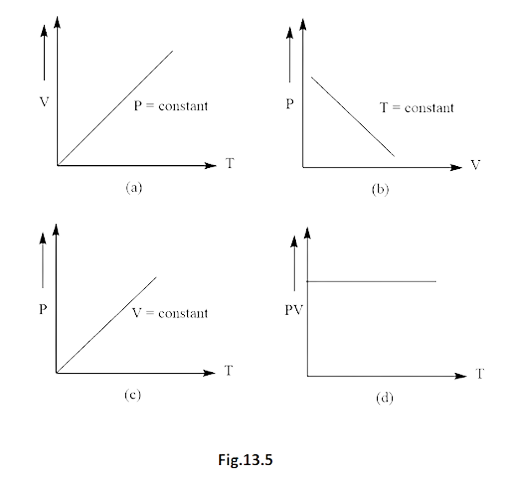
Ans. options (a) and (c)
The gas equation for ideal gas is
Where,
(a) When
Then,
Thus diagram (a) verified.
(b) When
Then,
Which means that graph should be parabola (Rectangular).
Hence, does not verify diagram (b).
(c) When
Which is the straight line
Thus, diagram (c) verified.
When
At
And at
Thus, the graph should pass through origin. But not in diagram (d). Hence does not verify diagram (d).
13. When an ideal gas is compressed adiabatically, its temperature rises: the molecules on the average have more kinetic energy than before. The kinetic energy increases,
(a) because of collisions with moving parts of the wall only.
(b) because of collisions with the entire wall.
(c) because the molecules get accelerated in their motion inside the volume.
(d) because of redistribution of energy amongst the molecules.
Ans. Option (a)
The mean free path becomes smaller because the ideal gas constricts, thus escalating the number of collisions per second among the molecules and walls. Because of which the temperature of gas increases which in turn escalates the Kinetic energy of gas molecules. Kinetic energy relies on temperature.
VERY SHORT ANSWER TYPE QUESTIONS
14. Calculate the number of atoms in
Ans. Quantity of atoms in
Quantity of atoms in
Number of atoms in
15. The volume of a given mass of a gas at
Ans. According to the gas equation of ideal gas
Here we can use units of pressure and volume differently but for temperature it should be the same.
16. The molecules of a given mass of a gas have root mean square speeds of
Ans.
Then
Where
17. Two molecules of a gas have speeds of
Ans.
18. A gas mixture consists of
Ans. For finding the total energy of the given molecule of the gas, we should find its degree of freedom. The molecule of oxygen has
Thus, total internal energy of
We know that Neon gas is monatomic so its degree of freedom is only
Thus, total internal energy of
Total internal energy of
19. Calculate the ratio of the mean free paths of the molecules of two gases having molecular diameters
Ans. Mean free path
Where,
Because the condition for both gases are identical so
Or
Or
SHORT ANSWER TYPE QUESTIONS
20. The container shown in Figure has two chambers, separated by a partition, of volumes
Ans. According to ideal gas equation
The gases in chamber
When we remove the partition between gases then
According to the kinetic theory of gases
The kinetic translational energy
Thus, kinetic translational energy by the gas of
And
Adding both above
Or
Combined effect,
21. A gas mixture consists of molecules of types
Ans.
According to the question, because temperature and pressure are same
And
Thus,
Thus, decreasing order of
(b) rms speeds.
Ans:
Where
22. We have
Ans. volume of
[
Number of moles in
At constant temperature ideal gas,
Thus, compressing the volume of the gas of the order of nuclear force of interaction will play the role, as in kinetic theory of gas molecules do not interact with each other thus gas will not obey the ideal gas behaviour.
23. When air is pumped into a cycle tyre the volume and pressure of the air in the tyre both are increased. What about Boyle’s law in this case?
Ans. By Boyle's law; the volume of gas is inversely proportional to pressure at constant temperature which means it is valid only for constant mass of gas. But in this question, air is pumped continuously in the tyre, so the number of moles of air increases which violate Boyle's law.
24. A balloon has
(a) the number of atoms of helium in the balloon,
Ans. For helium gas
(a)
(b) the total internal energy of the system.
Ans: As
Total
25. Calculate the number of degrees of freedom of molecules of hydrogen in 1 cc of hydrogen gas at NTP.
Ans. As we know, the hydrogen molecule is diatomic so it contains three translational degrees of freedom and two rotational degrees of freedom.
Thus, total degree of freedom in
The number of molecules in
Thus, total degree of freedom
26. An insulated container containing monatomic gas of molar mass
Ans. As the gas is monatomic thus, the total degree of freedom is three which will be because of only translational motion.
Thus, if
When there is a stop in an insulated container then its Kinetic energy is transferred to gas molecules in the form of translational
Assuming it be
Thus, increase in translational
LONG ANSWER TYPE QUESTIONS
27. Explain why
(a) there is no atmosphere on the moon.
Ans. (a) Acceleration due to gravity on the moon is
Because
The molecule of air can escape out due to the small gravitational force and
Because the distance of the moon from the sun is roughly equal to that of earth, thus the intensity of energy of the sun reaches to the moon is larger because of the lower density of the atmosphere. Distance between the moon and sun becomes smaller than earth when the moon is towards the sun during its rotation around the earth.
Because of this, the rms speed of molecules increases and some of the molecules can speed up more than escape velocity and so the possibility of escaping out increases. Thus, over a long-time the moon has lost most of its atmosphere.
(b) there is a fall in temperature with an increase in altitude.
Ans: Because of the kinetic energy of air molecules, the temperature of the atmosphere. Molecules of air rise up because of lower atmospheric pressure at higher altitude so their potential energy increases in turn the kinetic energy decreases resulting in a decrease in temperature. Because of lower pressure at higher altitude the gas expands and gives a cooling effect and thus decreases the temperature.
28. Consider an ideal gas with the following distribution of speeds.
Speed m/s | 200 | 400 | 600 | 800 | 1000 |
% of molecules | 10 | 20 | 40 | 20 | 10 |
(i) Calculate
Ans.
(ii) If all the molecules with speed
Ans: When molecules escape
29. Ten small planes are flying at a speed of
Ans. we can consider the planes as the motion of molecules in confined space. The distance between the two planes travelled between the collision or just to avoid an accident is time of relaxation for the mean free path
30. A box of
Ans. Volume of the box
Initial pressure
final pressure
air pressure outside box
Initial temperature
Final temperature
initial pressure difference between atmosphere and tyre
mass of a
Assuming
At time
Half is multiple as half molecule will strike to opposite wall
Thus,
At time
Temperature inside the air and box are equal to
At time
Total number of molecules going out from hole at time
Gas equation
For box,
Assuming after time
Thus, new final density of
Thus, total number of molecules going out from volume
Net number of molecules going out in time
In
From (V) and (IV)
31. Consider a rectangular block of wood moving with a velocity
Ans. Assuming
The velocity of gas molecules
The gas molecules strike to the front face in opposite direction when box moves in gas and on back face in the same direction as
Thus, relative velocity on the back face =
By a molecule on front face, change in momentum
By a molecule on back side, change in momentum
At
To front face
Number of molecules striking to front face
As the speed of bloc and molecule striking on backend face
Due to striking the molecule on front face, total change in momentum
Thus, the rate of change of momentum on front face is equal to the force
Force on back end
Net dragging force
Due to gas molecule, magnitude of dragging force
The kinetic theory is a theory that can be applied to a variety of particles, including atoms and molecules. The characteristics of gasses are frequently studied using kinetic theory. The Brownian motion provides a decent visual representation of particle flow and possible collisions.
Expert Physics teachers at Vedantu deliver NCERT Exemplar Solutions for Class 11 Physics Chapter 13 from the NCERT. In NCERT Exemplar Class 11 Physics, Kinetic Theory is one of the easiest topics. You will learn about ideal gas in this Chapter, which strictly follows gas laws such as Charle's law, Boyle's law, Gay Lussac's law, and others. Graham's law of gas diffusion, kinetic interpretation of temperature, the law of energy equipment, and degrees of freedom are among the Chapter's primary subjects.
Kinetic Theory comprises roughly 5 exercises and a total of 31 problems in Chapter 13. These NCERT Exemplar Class 11 Physics Problems and Solutions for Chapter 13 may aid in exam preparation and revision. While some questions may be difficult to understand at first, with our help, you will be able to complete the exercise. For all exemplar challenges, we always provide step-by-step solutions at Vedantu. To provide you with these answers, our subject matter experts conducted extensive studies on the issues. Read them once and you'll be able to answer all of your questions fast.
NCERT exemplar problem book and Solutions for Class 11 Physics PDF (Download) are available for free on the Vedantu app and website. NCERT Class 11 Physics solutions include both part 1 and part 2 textbook solutions. There are 15 Chapters in the NCERT Solutions for CBSE Class 11 Physics. This website has NCERT exemplar problems and solutions in PDF format for Class 11 Physics. Exemplar Solutions for NCERT Physics Class 11 Only the most recent CBSE curriculum and Physics NCERT Class 11 PDF example questions and solutions are available in Vedantu.
NCERT Physics Exemplar Solutions Class 11 Chapter 13 - Kinetic Theory Important Topics
Theory of Kinetics
According to the kinetic theory of matter, all matter is made up of microscopic elements in random motion with space between them. This demonstrates that matter, regardless of its phase, is made up of discrete, moving constituents.
Matter's Molecular Nature
All things, according to the atomic theory, are made up of minuscule essential units called atoms, which can be described as tiny elements in constant motion that attract or repel each other depending on their inter-particle distance.
Gasses' Behavior
Straight-line motion is unsystematic for gas particles. Gas particles have more kinetic energy than liquid or solid components. Gasses have more kinetic energy than liquids or solids because they exist at higher temperatures.
An Ideal Gas Kinetic Theory
The kinetic theory of gasses assumes that a gas is made up of a vast number of different constituents called molecules. The volume of these molecules has no bearing on the total volume occupied by the gas in an ideal gas.
Law of Energy Equipartition
According to the law of energy equipartition, all degrees of freedom in a dynamical structure in thermal equilibrium share the total energy of the system equally. Each degree of freedom per molecule has a total energy of 21kT, where k is the Boltzmann constant.
Heat Capacity Specification
The quantity of heat energy required to raise the temperature of a material per unit of mass is known as specific heat capacity. It's also an example of a broad property because its value is proportional to the size of the system under examination.
Path of Least Resistance
A gas molecule follows a straight route between every two collisions. The mean free path is the average distance between all of a molecule's routes.
Why should You choose Vedantu's NCERT Physics Exemplar Solutions Class 11 Chapter 13 - Kinetic Theory?
NCERT Exemplar Problems with Solutions for Class 11 Physics Chapter 13 are available from Vedantu and are of the highest quality, accuracy, and effectiveness
These NCERT Exemplar solutions might assist you in swiftly comprehending tough topics and then solving questions.
You can do well in the CBSE Class 12 board exams if you use these problems from the NCERT Exemplar Book.
Our solutions offer solved problems to assist you in honing your question-solving abilities.
FAQs on NCERT Exemplar for Class 11 Physics Chapter 13 - Kinetic Theory (Book Solutions)
1. Is NCERT Exemplar for Class 11 Physics Chapter 13 - Kinetic Theory (Book Solutions) useful?
NCERT Exemplar Class 11 Physics Chapter 13 Kinetic Theory provides answers to the NCERT Exemplar book's Exemplar questions. Extra questions produced by Vedantu experts will aid you in your preparation for CBSE Class 11 and entrance exams such as NEET, JEE, JEE advance, and AIEEE. There are MCQs in this NCERT exemplar Class 11 Physics Chapter 13 PDF. Get the education from the right place. Students should study the book properly and practice daily to get good marks in examinations.
2. What does NCERT Exemplar for Class 11 Physics Chapter 13 consist of?
NCERT exemplar problem book and Solutions for Class 11 Physics PDF (Download) are available for free on the Vedantu app and website. NCERT Class 11 Physics solutions include both part 1 and part 2 textbook solutions. There are 15 Chapters in the NCERT Solutions for CBSE Class 11 Physics. This website has NCERT exemplar problems and solutions in PDF format for Class 11 Physics. The syllabus compiles with the main course. With the help of Vedantu, students can learn the problem questions in a simpler manner.
3. What type of questions should I incorporate in my preparation?
Vedantu lets you download the free PDF of NCERT Exemplar for Class 11 Physics Chapter 13. Matching, fill-in-the-blank, and true/false questions, as well as numerical problems, key derivations, worksheets, exercises, and HOTS The kinetic theory is a theory that can be applied to a variety of particles, including atoms and molecules. The characteristics of gasses are frequently studied using kinetic theory.
4. How does Vedantu help in preparation?
Expert Physics teachers at Vedantu deliver Class 11 Physics Chapter 13 from the NCERT. In NCERT Exemplar Class 11 Physics, Kinetic Theory is one of the easiest topics. You will learn about ideal gas in this Chapter, which strictly follows gas laws such as Charle's law, Boyle's law, Gay Lussac's law, and others. Teachers at Vedantu are well trained and provide expert advice to students. You can study the material in a simpler and easy to read manner.
5. How is Vedantu helpful?
NCERT Exemplar Problems with Solutions for Class 11 Physics Chapter 13 are available from Vedantu and are of the highest quality, accuracy, and effectiveness These NCERT Exemplar solutions might assist you in swiftly comprehending tough topics and then solving questions. You can do well in the CBSE Class 12 board exams if you use Vedantu. Physics has always been an important discipline and students should learn and understand the subject thoroughly. The book by Vedantu can help you grasp the concepts better.























